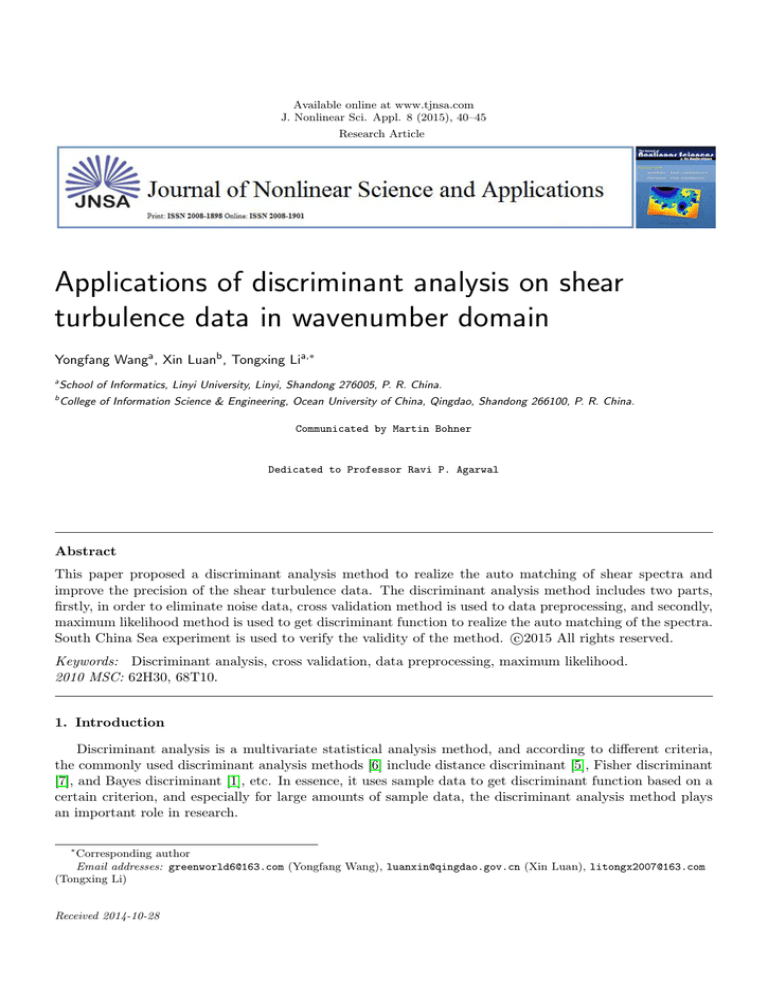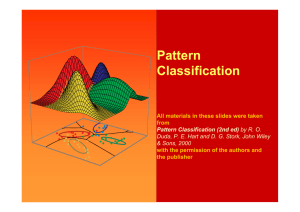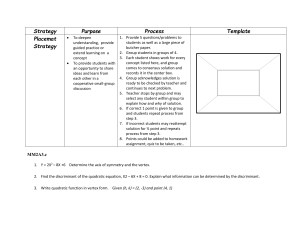
Available online at www.tjnsa.com
J. Nonlinear Sci. Appl. 8 (2015), 40–45
Research Article
Applications of discriminant analysis on shear
turbulence data in wavenumber domain
Yongfang Wanga , Xin Luanb , Tongxing Lia,∗
a
School of Informatics, Linyi University, Linyi, Shandong 276005, P. R. China.
b
College of Information Science & Engineering, Ocean University of China, Qingdao, Shandong 266100, P. R. China.
Communicated by Martin Bohner
Dedicated to Professor Ravi P. Agarwal
Abstract
This paper proposed a discriminant analysis method to realize the auto matching of shear spectra and
improve the precision of the shear turbulence data. The discriminant analysis method includes two parts,
firstly, in order to eliminate noise data, cross validation method is used to data preprocessing, and secondly,
maximum likelihood method is used to get discriminant function to realize the auto matching of the spectra.
c
South China Sea experiment is used to verify the validity of the method. 2015
All rights reserved.
Keywords: Discriminant analysis, cross validation, data preprocessing, maximum likelihood.
2010 MSC: 62H30, 68T10.
1. Introduction
Discriminant analysis is a multivariate statistical analysis method, and according to different criteria,
the commonly used discriminant analysis methods [6] include distance discriminant [5], Fisher discriminant
[7], and Bayes discriminant [1], etc. In essence, it uses sample data to get discriminant function based on a
certain criterion, and especially for large amounts of sample data, the discriminant analysis method plays
an important role in research.
∗
Corresponding author
Email addresses: greenworld6@163.com (Yongfang Wang), luanxin@qingdao.gov.cn (Xin Luan), litongx2007@163.com
(Tongxing Li)
Received 2014-10-28
Y. Wang, X. Luan, T. Li, J. Nonlinear Sci. Appl. 8 (2015), 40–45
41
In the research of ocean turbulence, the observation data is the basis to analyze its characteristics [10]. In
recent years, the analysis of turbulence data has been one of hot issues. Dong and Dosso [2] applied Bayesian
inversion to estimate seabed shear-wave speed profiles and their uncertainties from interface-wave dispersion
data. Piera et al. [11] proposed that using wavelet to identify the turbulence and calculate the Thorpe scale.
Xie et al. [15] found the anomalous change of the spectra in SCSMEX, and through analyzing the shear
spectra, they developed new view, new thinking, and new approaches to study the PSI mechanism. All of
the results are based on the observation turbulence data, which contains abundant information resources.
When the observed turbulence data is processed on computer, noise data will influence its accuracy,
and in wavenumber domain, the realistic shear spectra which are calculated from the observed turbulence
data will be compared with the Nasmyth empirical spectra [8] in dissipation subrange. Generally artificial
recognition method is used to evaluate the spectral quality, which is subjectivity and imprecise. Therefore,
the paper proposed a discriminant analysis method to improve the precision of the observed turbulence
data and realize the spectra auto matching. Section 2 introduces the wavenumber spectra in dissipation
subrange. In Section 3, the discriminant analysis method is introduced. Firstly, cross validation [12] is used
to get the valid data, and then maximum likelihood method [3] is used to get the discriminant function.
Section 4 introduces the result which is used to illustrate the validity of the method, and Section 5 makes
a conclusion about the method.
2. Wavenumber Spectra
Ocean turbulence data is acquired by sensor, and through electronic circuit system, it is converted into
digital signal, then through data processing technology [9], digital signal is changed into corresponding
physical parameters in wavenumber domain. Wavenumber spectra is one of the physical parameter, which
plays an important role to evaluate the characteristics of turbulence [13].
The shear spectra in wavenumber domain is shown in Figure 1, x axis represents wavenumber, y axis
represents power density spectrum (PSD). The black line is the realistic shear spectra, and the blue line is
the Nasmyth empirical spectra, the red dotted line is the Kolmogorov cut-off wavenumber [4], it is defined
as the reciprocal of Kolmogorov micro-scale, and the data after the red dotted line is not considered in the
method.
Figure 1: the wavenumber spectra
Figure 1 shows that noise energy will affect matching precision of the spectra, such as wavenumber
of 30, the PSD reaches 100, which is obviously due to the influence of noise data. Ideally, the realistic
shear spectra should fluctuate in a small range around Nasmyth empirical spectra, nevertheless in the
process of observation, noise is inevitable, so 10-fold cross-validation method is use to data preprocessing to
eliminate the noise data. In general, 10-fold cross-validation is a common test method to test the algorithm
accuracy, but in this paper it used to test the observed turbulence data category to get valid data. After
data pretreatment, based on the valid data in line with normal distribution [14], the maximum likelihood
method is used to estimate the characteristic parameters of the turbulence data, and then the quadratic
discriminant function is got according to the characteristic parameters. Finally, the effective fluctuation
Y. Wang, X. Luan, T. Li, J. Nonlinear Sci. Appl. 8 (2015), 40–45
42
range is obtained by the discriminant function to realize the auto matching of the shear spectra and the
noise signal is eliminated to improve the data accuracy.
3. Discriminant Analysis Method
Since noise signal will change the distribution characteristics of turbulence, cross validation method is
firstly used to eliminate the noise data, its purpose is to do data preprocessing for the discriminant function
in the next step.
3.1. Data Preprocessing
Cross validation method is a statistical analysis method, it divides the data set into two complementary
subsets: training set and testing set, the training set is used to modeling, and the testing set is used
to prediction. The commonly used cross validation methods are holdout, k-fold and leave one out cross
validation. The flow chat of k-fold is shown in Figure 2.
Figure 2: k-fold cross validation (S={S1, S2, S3})
In the paper, 10-fold cross validation is used to eliminate the noise data. The shear turbulence data S is
divided into 10 sets, 9 sets are used as training set: Sm, and the least one is used as testing set: Sn. The class
mid-value Vmid and its corresponding probability value Pmid of the training set are used to verify the testing
set. If the data in the testing set contains in the two values, then it will be marked as 1, and after 10-fold
cross validation, if the mark numbers of the data are less than 5, it will be regarded as noise data and then
eliminated. The flow chart of 10-fold is shown in Figure 3 (Assume A = {1, 2, 3, . . . , 10} = {x1 , x2 , . . . , x10 }.
If n = xi , i ∈ A, then m ∈ A − {xi }).
Figure 3: 10-fold cross validation (S={Sm, Sn})
Y. Wang, X. Luan, T. Li, J. Nonlinear Sci. Appl. 8 (2015), 40–45
43
3.2. Getting Discriminant Function
Since each observation of ocean turbulence, the observed data is large, we are looking for an effective
method to realize the shear spectra auto matching and improve the efficiency of the data processing. After
data preprocessing, according to the characteristic that turbulence data conforms to normal distribution, the
maximum likelihood method is used to get the parameters of the probability density function, the parameters
makes the probability that sample data appears maximum, and finally the discriminant function is got by
the parameters. Generally maximum likelihood is analyzed under two different conditions: discrete random
variables and continuous random variables. Here we use the discrete random variables condition.
The probability distribution of shear turbulence data S is P {S = s} = p(s; θ1 , θ2 , . . . , θk ), and the
probability distribution of S1 , S2 , . . . , Sn is
P {S1 = s1 , . . . , Sn = sn } =
n
X
p(si ; θ1 , θ2 , . . . , θk ).
i=1
Then the likelihood function is
L(θ1 , θ2 , . . . , θk ) =
n
Y
p(si ; θ1 , θ2 , . . . , θk ).
i=1
It indicates that the possibility of the data appears, and θ is the parameter of the probability density
function.
Since parameter θ is unknown, maximum likelihood is used to find an optimal parameter θ to maximizing
the probability, and then the quadratic discriminant function of shear turbulence data is constructed by
parameter θ. The process of the maximum likelihood is shown as follows:
(1) Firstly, we get the likelihood function of valid data through mean value µ and variance value Σ, the
likelihood function is
n
Y
1
1
T −1
L(s1 , s2 , . . . , sn |θ) =
exp − (si − µ) Σ (si − µ) .
2
(2π)1/2 |Σ|1/2
i=1
(2) Secondly, through
∂|A|
= [adj(A)]T = |A|(A−1 )T ,
∂A
∂log(L)
= 0,
∂µ
and
∂log(L)
= 0,
∂Σ
the maximum likelihood estimation of the parameters m and Σ̂ are got.
(3) Thirdly, the discriminant function is
1
1
T −1
p(svalid ) =
exp − (s − m) Σ̂ (s − m) .
2
(2π)1/2 |Σ̂|1/2
Finally, the discriminant function is got to realize the auto matching of the spectra, and then the South
China Sea observation experiment is applied to evaluate the effectiveness of the progress.
4. Results
The ocean turbulence observation instrument is Vertical Microstructure Profiler (VMP), the falling depth
in the ocean is 146m, and the average sinking velocity is 0.73m/s. Through computer graphics processing,
these signals are change into graphics, which are shown in Figures 4 and 5.
Sampling time is 240s and sampling frequency is 1024Hz. After used the cross validation method, the
normal distribution fitting of the valid data is shown in Figure 6, it indicates that the valid data is in line
with Gaussian distribution, which coincides with Townsend’s result.
Then discriminant function is used to realize the shear spectra auto matching, which is shown in Figure
7, we can see that at the frequencies of the fluctuation (such as 30Hz, 40Hz), the peaks are apparently
reduced.
Y. Wang, X. Luan, T. Li, J. Nonlinear Sci. Appl. 8 (2015), 40–45
44
Figure 4: Falling depth
Figure 5: Sinking velocity
Figure 6: Normal distribution fitting
Figure 7: the change of the wavenumber spectra before and after
5. Conclusion
High accuracy of the observation data plays an important role in ocean turbulence theory research.
In the paper, we find an effectively discriminant analysis method to study the characteristic of the ocean
turbulence and provides some new way to process the shear turbulence data, and finally the results indicate
that the method is feasible and effective. However, due to the limitations of the observed turbulence data,
the method still needs to be further optimized to fit the complexity of the marine environment, and then,
Y. Wang, X. Luan, T. Li, J. Nonlinear Sci. Appl. 8 (2015), 40–45
45
most importantly, the information contained in the observed turbulence data needs to be further mining.
Acknowledgements
This research is supported by the AMEP of Linyi University, P. R. China.
References
[1] George E. P. Box, George C. Tiao, Bayesian Inference in Statistical Analysis, John Wiley & Sons, Inc., (1992). 1
[2] H. Dong, S. E. Dosso, Bayesian inversion of interface-wave dispersion for seabed shear-wave speed profiles, IEEE Journal
of Oceanic Engineering, 36 (2011), 1–11. 1
[3] F. Ince, Maximum likelihood classification, optimal or problematic? A comparison with the nearest neighbour classification,
International Journal of Remote Sensing, 12 (1987), 1829–1838. 1
[4] A. N. Kolmogorov, Dissipation of energy in the locally isotropic turbulence, Proceedings of the USSR Academy of Sciences,
32 (1941), 16–18. (Russian). 2
[5] J. Liang, S. Yang, A. Winstanley, Invariant optimal feature selection: A distance discriminant and feature ranking based
solution, Pattern Recognition, 41 (2008), 1429–1439. 1
[6] G. J. McLachlan, Discriminant Analysis and Statistical Pattern Recognition, John Wiley & Sons, Inc., (1992). 1
[7] S. Mika, G. Rätsch, J. Weston, B. Schölkopf, K.-R. Müller, Fisher discriminant analysis with kernels, Neural networks
for signal processing IX, Processing of the 1999 IEEE Signal Processing Society Workshop, (1999), 41–48. 1
[8] P. W. Nasmyth, Ocean turbulence, Ph. D. Thesis, University of British Columbia, Vancouver, (1970). 1
[9] N. S. Oakey, Determination of the rate of dissipation of turbulent energy from simultaneous temperature and velocity shear
microstructure measurements, Journal of Physical Oceanography, 12 (1982), 256–271. 2
[10] J. Piera, Signal processing of microstructure profiles: integrating turbulent spatial scales in aquatic ecological modeling,
University of Girona, (2001). 1
[11] J. Piera, E. Roget, J. Catalan, Turbulent patch identification in microstructure profiles: A method based on wavelet
denoising and Thorpe displacement analysis, Journal of Atmospheric and Oceanic Technology, 19 (2002), 1390–1402. 1
[12] J. Shao, Linear model selection by cross-validation, J. Amer. Statist. Assoc., 88 (1993), 486–494. 1
[13] G. I. Taylor, The spectrum of turbulence, Proceedings of the Royal Society of London. Series A–Mathematical and Physical
Sciences, 164 (1938), 476–490. 2
[14] A. A. Townsend, The Structure of Turbulent Shear Flow, Cambridge University Press, Cambridge, (1980). 2
[15] X.-H. Xie, X.-D. Shang, G.-Y. Shang, L. Sun, Variations of diurnal and inertial spectral peaks near the bi-diurnal critical
latitude, Geophysical Research Letters, 36 (2009), L02606. 1






